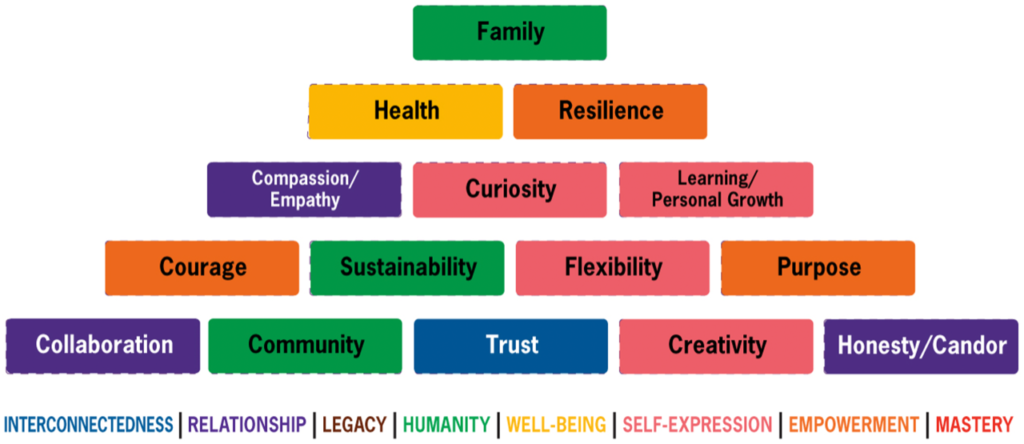All too often, company values are just words on a website or a poster on the wall which were decided by the people at the top and are expected to trickle down into the behavior of each team and each individual. When this top-down approach is taken, company values don’t always connect with individuals on a personal level, and therefore, they aren’t easily actualized in the workplace. So, how do we get individuals to truly connect with organizational values? Work to integrate values from the other direction – upward. This means starting with the individual and their own values and setting them up to successfully connect those values to their work in a meaningful way. In this blog, we will discuss DILAN’s unique process of providing a space to accomplish this alignment of personal, team, and company values.
Understanding Shifting Values in the Workplace
Values help create a sense of purpose for employees, in their work and personal lives. Being able to clarify and articulate a personal set of values allows employees to connect more meaningfully to their work bringing more intentionality to their contributions. But what happens when people’s values change? Research supports that individual values can shift and change as people move through their life cycle and adjust to challenging environments, and after a turbulent last few years, many employees have experienced a shift in what matters most to them–maybe that’s their health, their family, their sense of stability. Whatever changes in values they’ve experienced, they are now left trying to find ways to accommodate this new shift in values in the workplace.
If we want to create an environment where employees are engaged and find meaning in what they do, we have to prioritize the alignment of values as we come out of a hectic few years and move forward into the future.
How can you do this effectively in an organizational setting?
Facilitate an opportunity for employees to identify what has shifted in their personal values. This will help provide clarity and understanding around how to connect their new values to their work. Setting aside time to refresh and renew your team’s values will help deepen their sense of purpose in their work.
How to Align Personal Values with Team and Company Values
Step 1: Have people identify and acknowledge their own values
First, it’s important to create space for your employees to clarify their own personal values. They may have a strong sense that their values have shifted over the past few years, but they may not have ever vocalized or organized these thoughts.
DILAN uses a technique called Values Edge 2.0 to help align personal and team values by having team members sort through a core group of 56 values and identify 15 core values. These core values should clearly reflect their personal choices and actions. Once these are identified, they are then challenged to sort the 15 core values into a ranked pyramid to give them a solid understanding for making personal decisions. A thorough understanding of their own values is the foundation for bringing values to life at work.
Step 2: Identifying team values
Once team members have identified and ranked their own personal values, they can choose which they want to bring forward into the workplace. Take time together to identify a core group of 6-10 team values based on the individual ones that overlap. As a team, which values do you want to focus on? Which can you commit to prioritizing together?
This will help guide and clarify how team members will behave and will bring a sense of shared alignment about what will guide the team’s efforts moving forward. Even just discussing these values and determining together which will influence team behaviors will help your team feel a sense of ownership and agency over the team culture and work.
Step 3: Translate these team values into behaviors
Once team values are identified, the team should determine together what it looks like, sounds like, and feels like when these team values are being upheld. Have discussions about the behaviors that demonstrate values like “respect,” “trust, or ”positivity” and create shared clarity and agreements about how people live out these values at work.
For example, if a team value is “positivity,” it may require that the team remove certain phrases from the workplace vocabulary like “this won’t work” or “I won’t be able to do that in time” and work to optimistically come up with solutions. Discussing clear, tangible ways to exhibit your team values deepens the connection between employees and helps unite the team around the values that actually matter to them. It’s also important to create a safe space for acknowledging when the values aren’t being actualized and for figuring out how everyone can improve together. This alignment creates a guide for making decisions and communicating with team members when faced with challenges.
Connecting to Organizational Values
Once your team has a good understanding of the values they are committed to upholding, you can help them identify how these values connect to the values of the organization. This creates a stronger connection to the overarching mission of the company and more tangible action steps to actually uphold the company’s values rather than just having them on a poster on the wall.
When there is a clear connection between an employee’s personal values, the team’s values, and the organizational values, you create a more cohesive company culture that results in more meaningful work.




